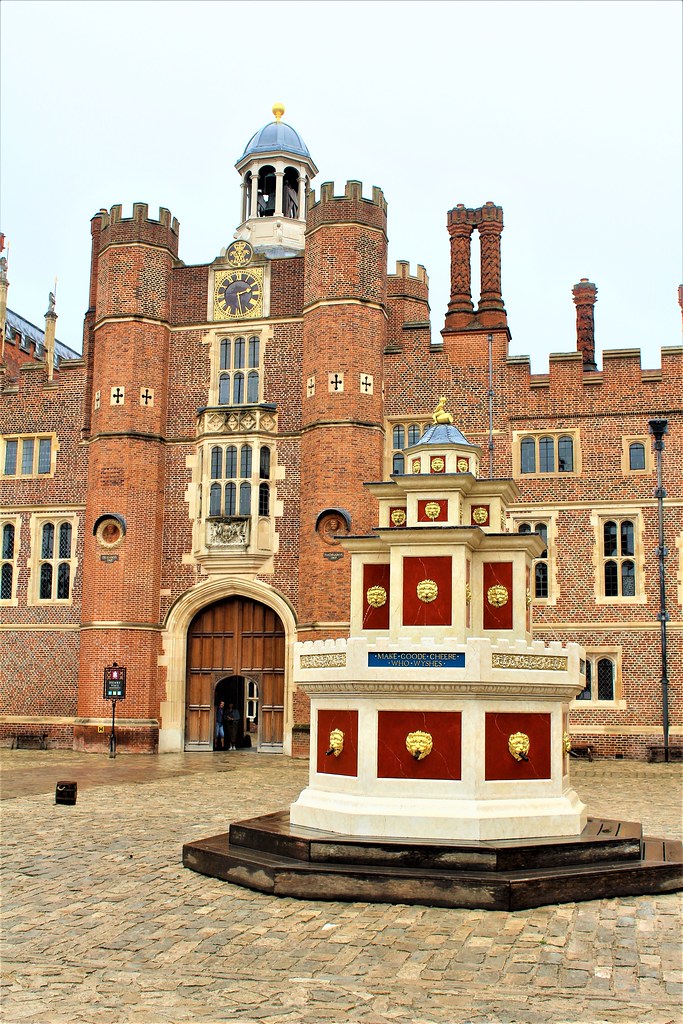One day tour of historic English sites
 Tudor style entertainment at Hampton Court Palace
Tudor style entertainment at Hampton Court Palace
This evening, I am reprising a day tour of two important historical sites in England albeit which are separated by about 1100 years.
First stop was Chedworth Roman Villa in the Cotswolds, near to Cirencester.
 Artist's impression of Chedworth Roman Villa at its peak
Artist's impression of Chedworth Roman Villa at its peakThis high status complex commenced around AD 120, possibly a few years earlier, and reached its zenith in the late 4th century AD.The site is distinguished by opulence, in particular the extremely high quality floor mosaics, bath houses and centrally heated living quarters, all on a grand scale as illustrated in the artist’s impression above. The Villa went into decline in tandem with the collapse of Roman power in the late 4th and early 5th centuries. It was re-discovered by chance in 1864 when first excavated and has been open to the public ever since.
The rich and vibrant colours of the mosaics (illustrated below) have survived some 1700 years burial underground and are testimony to the skills of the craftsmen who were responsible for the work. They probably worked from a base in nearby Corinium ( Cirencester).
More Information:
- The site was probably chosen because of the existence of fresh water from a natural spring which rises at head of the small valley (combe) in which the villa is located.
- Here can be found good examples of Roman under-floor heating known as hypocausts.
- Key facilities include two bath houses, a water shrine, dining room, kitchen and latrine.
- Chedworth is unusual in that the complex includes two bath houses and two dining rooms.
- Evidence suggests an intensely decorated interior, mostly in bold colours.
- The site is owned and managed by England’s National Trust, a major heritage organisation.
 2018 excavations on north wing
2018 excavations on north wing Illustration of north wing bath house and living complex.
Illustration of north wing bath house and living complex.
Circle is possibly an early Christian Chi-Rho symbol. Third century reenactment to illustrate attire of high status female.
Third century reenactment to illustrate attire of high status female. Bath house with mosaic floor
Bath house with mosaic floor Mosaic floor in West Range
Mosaic floor in West Range
Next to Hampton Court Palace on the banks of the River Thames and which lies about fourteen miles S.W. of London.
Hampton Court Palace is closely associated with King Henry VIII of England. Cardinal Wolsey (Henry's administrator) presented Henry with the Palace in 1525. This was a red brick Tudor palace. Subsequently, baroque style additions were completed in the late 17th century. This extensive building includes:
- The Wolsey Rooms
- Henry VIII's Apartments
- The chapel Royal
- West Front
- Base Court
- Clock Court
- Fountain Court
- Kitchens
- William III's Apartments.
- Queen's Staircase.
- Cumberland Art Gallery.
Replica Wine Fountain Tudor era elaborate food preparation.
Tudor era elaborate food preparation. Fountain Court
Fountain Court Gardens with Palace in background
Gardens with Palace in background Palace from River Thames
Palace from River Thames Entrance
Entrance


Comments
Post a Comment